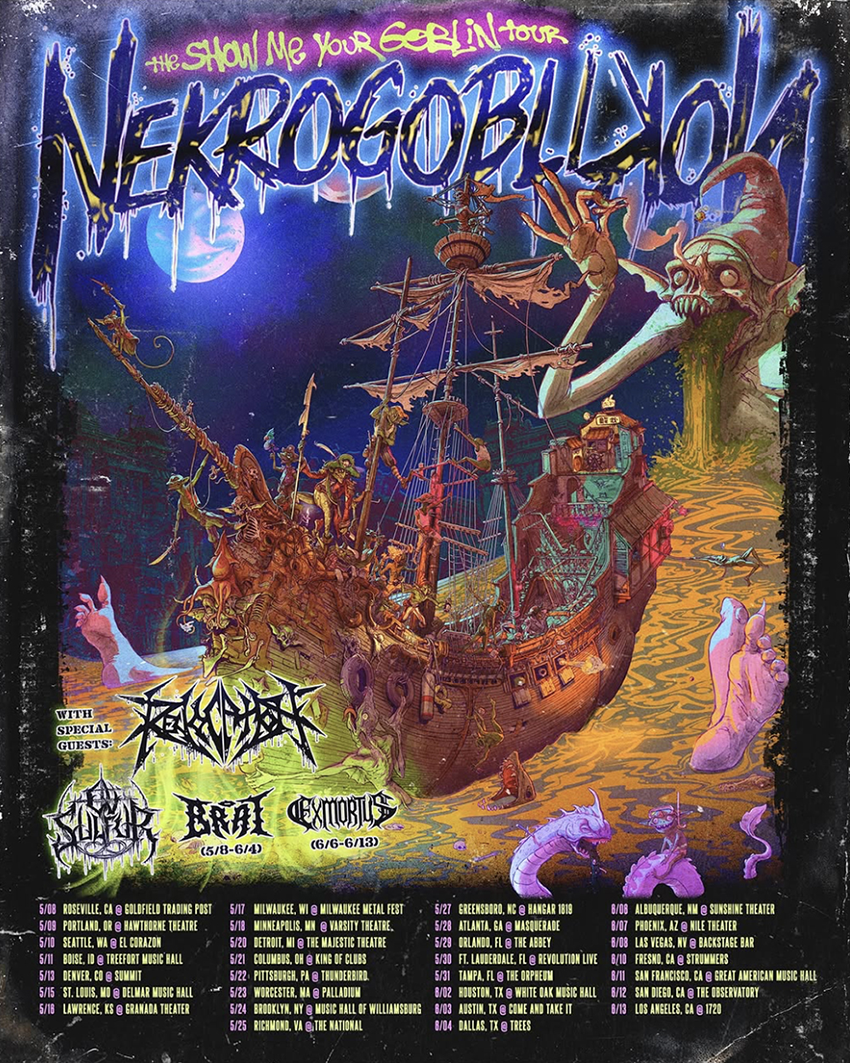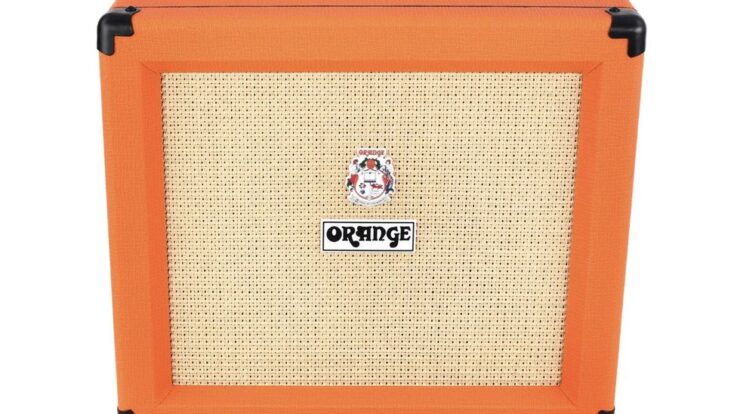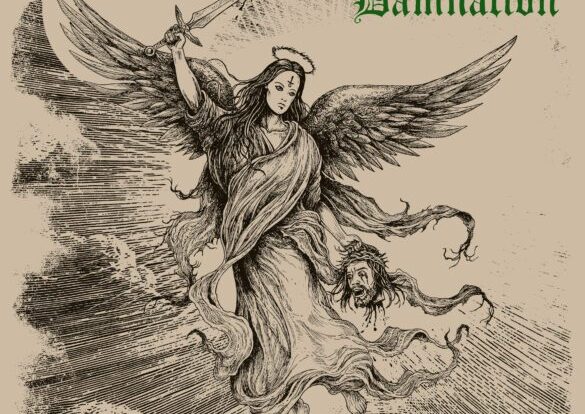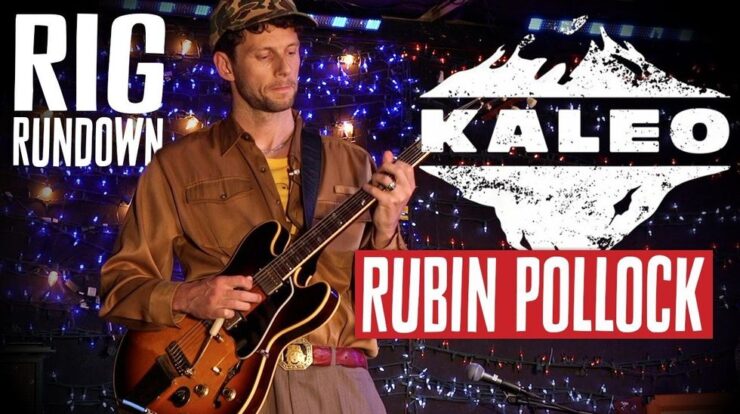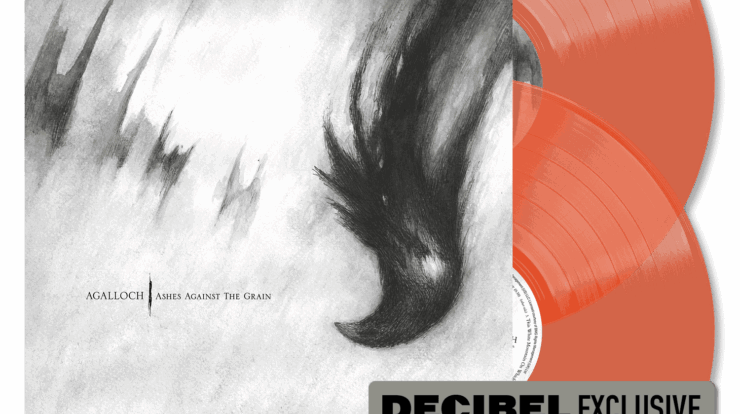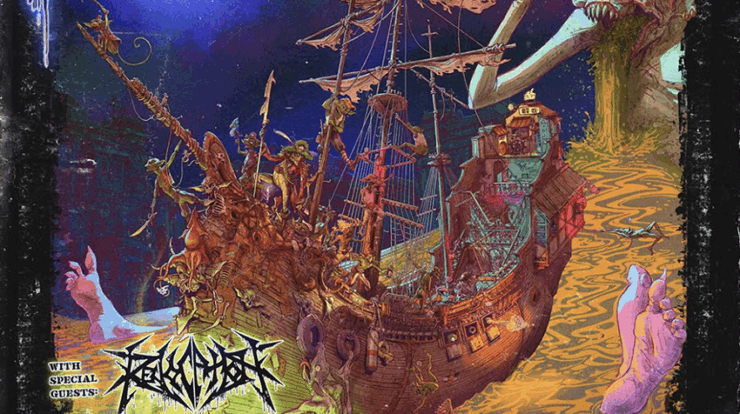
This post was originally published on this site
Want in on a dirty little secret? In the Kill Screen arcade, our guests are often asked whether they encounter fellow nerds among the bands with which they tour. That’s not just a layup of a question—we’re earnestly digging for names. It’s not always obvious who in our community is glued to a controller and to retain our title as gaming’s most extremely extreme column, some inside info is needed. So when previous player character and Summoning the Lich vocalist David Bruno informed us that Nekrogoblikon drummer Eric W. Brown is not only a lifelong gamer, but the staff composer and audio designer for Sabotage Studio, pay dirt was struck. Currently, the Québec-based company has two titles to their credit: 2018’s The Messenger, an action platformer in which the protagonist time travels between the 8-bit past and the 16-bit future, and 2023’s Sea of Stars, a love letter to Super Nintendo-era turn-based RPGs and Rob Fusco of One King Down’s favorite game of 2023. Even having played the studio’s releases previously, the metalhead lifer’s appearance felt hidden in plain sight to us.
While Brown talks to us during the lead up to 2025’s Show Me Your Goblin Tour, his decades of experience extend far beyond the goblin metal outfit’s history. In addition to either actively or formerly manning the drum throne in groups like Inferi, Swashbuckle, Vale of Pnath and Wizardthrone, it’s his corpse-painted chiptune persona Rainbowdragoneyes that caught the attention of the Canadians that would contract his services. Though the solo project is electronic—all of the music is programmed on and performed via a Game Boy—his growled vocals, dedication to limitations and high-energy performances convey an undeniable metal spirit that carries over to his work at Sabotage. It may have taken the co-nerds a moment to get a clue, but right now we’re happy to hear what he has to say.
What was your first gaming experience?
I’m pretty sure it was Atari 2600. My dad had one, I must have been four or five years old. But then after that, I started on the Sega Genesis. I’m a Genesis kid—Mega Drive for you Europeans out there. I went from that to N64 to PS1 to PS2, and then I kind of took a break for a while and then I got back into it with the Switch when The Messenger came out.
What caused the break?
Honestly, I was still playing the same retro games. I think a lot of it was that I was just so poor for a really long time. I kind of struck out on my own when I was 17 basically, almost 18. But I’ve just been trying to figure it out since then and lived in a bunch of different places. Mostly I was just living paycheck-to-paycheck for a couple of decades there. I was working a lot and I was also playing music. It wasn’t really any good reason, I just didn’t really invest in any new consoles. I would play them from time to time at people’s houses or whatever and was always jealous. I think that was probably the main reason. I never stopped playing Genesis and N64.
What were the games that stuck with you during that nature period? What are the Genesis standouts?
Gunstar Heroes, top one. Jurassic Park, Jurassic Park: Rampage Edition, The Lawnmower Man, Vectorman, Decap Attack. The Lion King always messed me up. NHL 96, specifically 96. I think that was when they started the character creator. Ricky Superstar was my custom character—all of his stats maxed out and he was just tackling everybody. I figured out the hack where you could skate around the goal and then just slip it in. It was almost a 100 percent success rate on that. That was fun. I was playing with my younger brothers on a lot of those.
At the time of this interview, you just got back from an Australia/New Zealand tour with Nekrogoblikon. Do you ever bring any gaming out with you or is that a strictly “at home” thing? Do you ever come across fellow nerds when you’re out on the road?
Yeah, 100 percent. I play goblin metal, it’s all nerds out there—internally and externally. But yeah, I’ve got a Steam Deck, which I’m very happy with. We all have Switches and then the Steam Deck kind of became the thing. Pretty much all of us play Switch or Steam Deck or both, and we’re all playing PlayStation at home. I remember it was on the Dethklok tour, I don’t remember the show, but there was a nice young lady who brought a few Nintendo DSs. We were all shoved together in the smoking area of the venue and she just thrusts a Nintendo DS in our hands and forced us to play Mario Kart. So we were just playing Mario Kart on DS around, like, dozens of people smoking cigarettes. I don’t know, it was pretty fun.
What have you guys been playing lately?
Honestly, I’ve been playing the Sea of Stars DLC pretty non-stop because we’re finishing that up. I’m more on call, but I’m basically using every spare moment I have right now to make sure I do everything I need to do because I’m also in charge of all the sound design and everything. But I just started High on Life on PS5. It was free and that one’s pretty fun.
I kind of find myself getting into games and then just walking away for a while, getting distracted with something else and then I just never come back and finish the game. There’s a really short list of games I’ve actually beaten and there’s a much longer list of games that I’ve just never bothered to finish. Maybe I will one day.
You touched on this already, but you’re the audio guy for Sabotage Studio. What was the reality like versus your expectation going in?
It’s worth saying that I got the gig because I was creating my own chiptune music. I had a chiptune project called Rainbowdragoneyes where I put on corpse paint and I’m screaming over Game Boy backing tracks and it was a one-man show. It was just me on stage and it was usually in front of a metal audience that wanted to see a full band, so I would have to really work to win them over. Or just piss them off, and either way was good with me. I had a good time up there. I was giving 112 percent regardless if they were into it. I always had a few fans there and would sell some merch.
But I was writing, releasing my own music, going on tour and then [Sabotage Studio president and creative director] Thierry [Boulanger], before he even founded the company, just became a fan. And then we met up in Québec and he had this whole pitch, like, “Hey, so, I’m building this game, blah blah blah,” and I sort of cut him off and it’s like, “Yeah, I’ll make music for your game. Why not?” As a chiptune/8-bit music guy, you get hit up from time to time: “I’m doing a game called Pixel Man and we need a title screen and a level music. This is a mobile game,” or whatever. There’d be little projects like that. I didn’t know this guy, obviously. I could tell he was passionate, but we didn’t know each other yet. So I was just like, “Sure, I’ll make some music and we’ll just see what happens.” And he seemed pretty confident; cautiously optimistic, as you are about starting your own venture. That came to be that way, and then I definitely did not expect it to blow up in the way that it did. The studio itself has a fan base now and people like playing RPGs for the first time because they love The Messenger and they get what we’re about and trust us to do it in the right way. A lot of eyeballs and ear-balls, more than I could have anticipated or expected.
Was there any kind of difference in approach between what you were doing with Rainbowdragoneyes and your solo work on either a conceptual or technical level, or was it a pretty easy one-to-one transfer of skills from solo to team?
It was very much one-to-one. He was like, “I love your music. I want you to do that, but for this.” It’s an action game, so it was pretty easy. I just love writing fast, upbeat, catchy music. The only real difference was that video game music has to loop, having never worked on a video game before really other than just sending off some tracks into the void. But as the project was coming together, it started to become more of a full-time thing. And then I downloaded Unity and I started learning how to use that, figuring out how the implementation side of it went. That sort of informed how I could do not only the music, but the sound effects.
I was originally commissioned as a composer, and just sort of grew into this role of designing and managing all the audio in the game. The Messenger was a nights and weekends project until they got funding from the Canadian government to actually pay employees to work on it full-time. The audio side, especially being remote and being a touring musician, it was always kind of like I’m in and out. But then I was in the Slack channels and we’re updating each other all the time, and I would go out to Québec for, like, a week a few times a year and work in the studio.
The initial pitch was 12 levels. There’s time travel, so we need two versions, so that’s 24 tracks. “Oh yeah, and can you do a sound effect for the sword and a jump and the enemy…?” I’m like, “Yeah, sure, all good.” And as the process went on, I think we ended up with over 60 tracks and over 300 sound effects. As I’m learning the tools, I’m like, OK, so this is how I add a thing to that, and there’s all this stuff here where… That would actually make sense if we had something unique for that… So it was a learning process, but I was getting really into it. It was sort of shaping up as it was progressing.
Me being the audio guy, I’ve got the ear for what would work better in this context rather than reusing the same sound effect for, like, five different things. But then the other side of that is we make like retro-style games, so you don’t want to take it too far in that direction. You kind of want to purposefully reuse some stuff because that’s how they used to do it when there was 32 KB of memory. The same with the animation. Garl, one of the characters in Sea of Stars, he’s got a scar over his left eye. As his sprite is walking around, if he turns the other way, the scar switched sides—they would use sprite mirroring. Initially, they had fully animated all of his run cycles in every direction with the scar on the left side, and then they rolled it back. They were like, “It would feel more retro if we just use sprite mirroring.” And then a couple of people have noticed that and be like, “Uh, I think it’s a bug. His scar keeps switching sides.” No, actually. That was purposefully designed.We had it that way and we decided we didn’t like it, so we rolled it back.
See, I [James] like that kind of stuff. Trying to design something now to be retro I’m sure involves a lot of detail. But when something breaks that illusion for me, I find that I’m kind of like, [disappointedly] Aww… OK.
Yeah, that’s kind of my problem with a lot of these pixel games. I would say, like, 85 percent of indie games are pixel art. And they might have a synthwave soundtrack or they might have some orchestration or whatever, and there’s just this disconnect between what you’re seeing and what you’re hearing. Also with the [user interface], when the vector text pops up and there’s no sense of scale to the actual pixel art. I don’t mind pixel art as an aesthetic—I love pixel art—but if you’re setting out to design a retro-inspired game, there’s very specific limitations around that. You kind of have to create a set of rules or a framework to stay within, like a limited color palette or, in my case with The Messenger, I was using software to write the music that can actually be played back on a Nintendo. The program spits out a data file to actually be able to run on hardware.
I [Michael] was gonna say, didn’t you compose that on Famitracker?
Yeah, Famitracker, exactly. And then of course—because I’m crazy enough—I decided I wanted to keep it legit, so for the 16-bit side I used a different program and just reprogrammed the song in that. That was for the Sega Genesis chip and that stuff plays back on the Genesis. Basically, that’s why I got the gig—because I have that attention to detail and I already understand the tech and stuff like that. And I made all the sound effects in both of those programs as well.
There’s this attention to detail, you want it to be as true to retro as possible. The Messenger is much closer to the source material, but something like Sea of Stars, you definitely have to make some judgment calls. Is it basically “just keep it as true to the original until you can’t”?
There was a pre-production process where I just wrote a bunch of demos, trying to figure out the sound. I think we were still working on the Picnic Panic DLC at this time, so it was way before we ever started production on Sea of Stars. It goes back to the philosophy of the studio—where it’s retro aesthetics with modern design—and I take the same approach with the audio. Seeing as how I did a whole soundtrack in two different trackers, I was stoked to go back to Logic, a traditional DAW, and do this new game that way.
We really wanted to evoke that sense of nostalgia and the easiest way to do that is to use old sounds. I was pulling up Super Nintendo library sound fonts. There’s a company called Impact Soundworks, they make a library called Super Audio Cart. They actually sampled from hardware all these instruments and put it into a plug-in that you can manipulate and you can create a stack of four different layers, blend them together. I use that a lot. It’s worth mentioning all the Super Nintendo music was all sampled from commercial synthesizers of the time. It was just a really, really small snippet of a sample that was looped in hardware. That’s why it sounds jittery when you have a sustained note—it’s because this tiny little snippet is being looped. And so I started to track down which synths these composers were using back in the ’80s and ’90s. There’s VST versions of a few of them. I have a MIDI cartridge for Super Nintendo called Super MIDI Pak. It’s got a MIDI port in the top, so you basically plug this into your Super Nintendo, you can plug a MIDI controller into it and just play it like a synth. So I used a bit of that. It’s a bunch of different ways to achieve more or less the same result.
Basically where we landed was we wanted the Super Nintendo sounds to be upfront, carrying the melody, the composition. From there, I would add layers. I have an EastWest [Sounds] library called Stormdrum 3. Mickey Hart is one of the biggest percussion nerds in the world, he’s got the biggest private collection of percussion instruments. Stormdrum 3 is a multi-sample library of his collection, it’s all this ethnic percussion stuff. I had a lot of fun with that—big drums, small drums, shakers, metals, you name it. There would be a supplement of stuff like that. Even for the Super Nintendo sounds, I’d be layering, like, five or six different patches, pan some to the left and the right so you have this really dense patch. And it’s also going through reverb and delay, so it’s sort of got a hi-fi quality to it, but it still sounds like a Super Nintendo more or less. I called it SNES++, the style, the sound that we landed on.
When you compose stuff like that, are you given specific direction of, “This is the scene that we need to track for, this is what the characters are interacting with, this is kind of the tone we’re looking for,” or are you there on a Tuesday night, like, I think I want to make something like spooky cave sounding?
In the beginning, it’s both. And then as we start to set deadlines and milestones, you kind of need to plan out how to finish what. It’s also super important for me to actually be in the project and play testing every day, going through it, feeling it out and making adjustments along the way, like, This level actually takes a lot longer to beat because of a few puzzles, so I might extend it the track by like 16 measures. Me personally, hearing the song a thousand times before anyone hears it once, if it gets too repetitive for me, then surely it’ll be repetitive for someone else. You never know how long someone’s gonna be in an area. While it’s gonna be looping the entire time, you want the loop to be seamless and you want the player to be excited when it starts over again. If it’s too short, then it just gets annoying.
For sure there will be briefs to start things off. As we were building it out, the whole team is on the same page with the high-level story: “Here’s the game and it’s divided up into these different islands and then each island has a few different dungeons and a boss.” It’s an RPG, so the music really tells the player what to feel in that moment. That was probably the biggest challenge for me—certainly never done any RPG music and certainly not on this scale—writing a bunch of different styles and types of music. But then as things develop, it’s like, OK, how far can we take this? Do we actually have time to add another dungeon? There’s a cutscene here; that might need its own track because it’s sort of an important thing. And that wouldn’t be in the initial brief.
I’ll make decisions all the time where I’m only supposed to write two tracks, but given everything that happens in the span of those two tracks I might write three more because there’s cutscenes and then there’s a little side thing over here. As it comes together, everyone on the team does that in their own discipline, like the animators and the level artist and everything. Everyone’s self-motivated. We’re all doing our best to make it as sick as possible and eventually we have to reel it in and come back to reality where we’ve got a deadline to hit. I kind of wish there was no release date ever; we could just work on it for the rest of our lives. Unfortunately, it doesn’t work that way.
I know that Thierry met you at a show, but are you the sole metalhead? Did he come specifically for you for chiptune or is he also a metalhead?
No, no, he’s a metalhead. He’s a punk rocker I think first and foremost and then segued into metal later in life, but he’s all in now. We get down on nerdy power metal and stuff together. There’s a handful of people on the team that are either metalheads or they’re metal curious or they’re just into some metal. I was playing in a pirate band called The Dread Crew of Oddwood at the time and we were touring with Arkona. That was the show he came to that I met him at, but he’s since been to Nekrogoblikon shows. We have a lot of crossover taste in music, not just in metal.
I would say I’m the only career metalhead, I guess, on the team. But that’s not true because I work with [bassist/vocalist] Jake [Vincent Jones] from Æther Realm. He’s my best good buddy. I kind of brought him into the project after about a year or two and decided that I needed help managing 50,000 assets and a hundred billion songs. He worked with me on a few tracks. There were a few that he composed outright and then I sort of produced it and everything. He’s not a full-time member of the team, but he’s the other career metalhead on the team. He’s got all the Sabotage merch. He’s a part of the team, he’s just not in it every day pulling his hair out like I am. But he works hard and he does a great job. One day a week, maybe two days a week and then as we’re pushing toward deadline I’ll have him work a few extra days as well.
You’re talking about having to do all these play tests to make sure that the music sounds right. Has working in the games industry changed the way that you approach or appreciate games in any way?
Yeah, absolutely. Maybe some would think they don’t want to know how the sausage is made, but if I’m playing a AAA game with a billion dollar budget—that they actually use correctly—for sure. You see that Powered by Wwise logo on the legal screen? I’m constantly impressed by how good of a job the sound designers and composers and everything, but I think I’m more into sound design in video games as a consumer. That’s kind of what draws me in. I find that a lot of AAA soundtracks are just kind of same-y to me. It’s just like, “OK, great. You got another epic cinematic masterpiece. Congratulations.” But indie games are where it’s at for really good music.
Do you find yourself discussing games with people and focusing on the sound design?
I wouldn’t say I’m a sound design advocate in that way. Sound design is one of those mystery arts. If it’s done correctly, you don’t notice it, and if it’s done poorly, it sticks out and it pulls you out of the experience. And that’s kind of like being a drummer, too. You’re all the way in the back and there’s a blanket of fog, no one can see you and it’s hard to get a photograph of you. But if your drummer sucks in your band, your whole band sucks. That’s just facts. I always say there’s a lot of parallels between being in a band [and] working for a game studio.
You say “games industry,” but really I just work for Sabotage. I don’t do freelance. I don’t understand how people can manage multiple projects like that at once. But also, it’s kind of a full-time job doing sound design and implementation and mixing and play testing and composing and polishing transitions. It’s a lot.
But you are actively not only making games, but games that are reaching a wide audience and winning awards. Just because an author only writes one book, it doesn’t mean that they can’t call themselves an author. It’s like, “Oh, you’re an author? Name every book.”
Yeah, fair enough, for sure. I think when people say things like “games industry,” it’s this mysterious thing that’s in the ether, like, “How do I get into the industry?” Well, you make something. That’s really all it takes. It’s the same as like, “How do I be in a band?” I don’t know, you write music and you find people to play it with or you join someone else’s thing where they did that.
“I think when people say things like ‘games industry,’ it’s this mysterious thing that’s in the ether, like, ‘How do I get into the industry?’ Well, you make something. That’s really all it takes.”
We interview a lot of people who are really interested in contributing to a video game.
As a concept, it sounds very appealing, right? But I think the bottom line is it’s the same way I got the gig: by putting in 15 years of work. Any creative job you have, it’s kind of unique in that you have to front load all of the work for a really long time, put in your 10,000, your 20,000 hours, and then maybe you start seeing a return from that. People want to start at the cart before they have a horse… or something. That’s the hill I’m gonna die on. “How do I get into the game industry?” Well, what do you want to do? What are you good at? Pick something and get good at that, and then find other people that do other things. Or learn to code, make your own game. Plenty of people do that as well. And then there’s the matter of getting it played by people, which is a whole different conversation. But it’s the same with how do you get people to sacrifice three minutes of their life to listen to your song? Especially in an oversaturated market where everyone wants to cash in. There’s a lot of really good stuff out there, too, don’t get me wrong. But to be competitive, you have to be sick. As in “good.”
When we talked to Herman Li from DragonForce, obviously their song [“Through the Fire and Flames”] being such a huge part of Guitar Hero, we asked, “How did this happen?” And I think his answer was like, “You’ve got to go out there and pursue it and talk to them.”
Yeah. The term “networking” gets thrown around a lot, but even cold emailing works sometimes, and it doesn’t work if you don’t do it. Don’t be annoying and trying to shove your thing down people’s throats, but just try to meet people where they’re at. You can look around on social media, on Reddit or something. There’s at any given moment thousands of projects under development, and at least some of those might be looking for the exact thing you already have. Maybe it’s cheaper to grant a license for an existing piece rather than commissioning a whole new one, or they’ve already really attached to this thing that you did and it would be perfect for this. There’s a thousand different ways to go about it and all of them involve making your presence known, and also making your presence known as someone who isn’t a punisher or annoying, someone that people would want to work with.
And also, to be quite frank, I [Michael] would imagine a good bit of luck.
Yeah, of course. Luck is part of it, but I think luck comes from being prepared ahead of time. If you’re going after these opportunities and you’re like, “How do I write music for your video game?” It’s like, “Well, where can I listen to your existing music?” “Well, you know, I got this one thing…” That’s not good enough. You need a body of work that proves you are prolific at at least one thing. Definitely get good at several things, but for any aspiring composer out there, your golden ticket is going to be getting really good at something you enjoy making that you can do relatively quickly and unique to yourself. Get good at your sound. By all means, dabble in other things. But more often than not, the thing that you’re best at is what will work.
Who would you say are your main influences when it comes to chiptune?
Jake Kaufman, probably number one. He used to go by the name “virt.” He did the Shovel Knight music, but he had a forum back in the day called VGMix and there was a small community there of video game remixers. I just thought his stuff was brilliant, technically proficient. I got really into his stuff. Danny Baranowsky is really good. He did Super Meat Boy and [Crypt of the] Necrodancer and stuff. I really liked him. Disasterpiece [Richard Vreeland], I actually played a show with him at the Blip Festival in 2009. He’s done countless things. My old buddy Makeup and Vanity Set, he does a lot of soundtrack stuff for Netflix things. He’s really, really good at Robocop, ’80s, ’90s synthwave authentico analog synth type stuff. He’s sick, he’s done some stuff. The Algorithm, Rémi [Gallego], he’s probably one of my favorite artists ever. He’s done some indie game soundtracks, but his stuff is the perfect blend of electronic and metal in my opinion. Danimal Cannon, also a Game Boy musician who does sick production stuff. Both of those artists, Danimal Cannon and Algorithm, I somehow convinced to do a Rainbowdragoneyes remix for an instrumental album that I put out [Sinstrumental], and they’re definitely my favorite tracks on that album.
For somebody who is interested in taking a shot at chiptune, where would you recommend they start?
It kind of depends on what you want to do. I kind of fell in love with the idea of making music directly on the Game Boy, so I learned how to do it that way because it was the act of doing it that way that was appealing to me. There’s a billion different plugins you can use for 8-bit sounds. There’s a company called Plogue that makes really, muy authentico chiptune VSTs. These guys are retro nerds. They kind of emulate everything down to capacitors, they get really technical with it. That might be the easiest barrier to entry.
For me personally, making chiptune has always been a process of doing it within the limitations of the hardware. I would always use programs that don’t let me outside of those boundaries. Famitracker is a free program, it’s a wonderful program, one of the best. You can download that. There’s forums, I think there’s probably a bunch of videos out at this point. And I’ve been saying this for years, but I’m absolutely going to be doing tutorials of my own. I just can’t get outside this DLC realm right now and in between touring and stuff, I just haven’t had any free moments. But that’s all going to change soon and then I’m going to focus more on doing some video stuff and also reminding people that I’m a drummer and doing drum videos. I have all kinds of stuff I want to do that I just can’t right now.
By all means, hit me up, I love talking about this stuff. I do get a lot of the same kind of questions where it’s like. “How do I get started with it?” I would start with, “What do you want your approach to be?” Most of these tracker programs are free or they’re super, super low cost. You can download and use old versions of DefleMask for free, but now it’s on the app store for, like, $10, which is honestly really worth it in my opinion. It’s $10—like, come on. DefleMask, it’s multiple chips, so you can write for about, like, seven different consoles with that one program and it’ll actually give you the files to put it on a flash card to play it back on the thing.
I would say probably more people are going to be more comfortable in the VST/DAW realm because they’re used to that already. But for me, I cannot advocate for anything but doing it the authentic way just because that’s what chiptune is to me. Anything else is a “fake bit.” And I can always tell as well. They think they’re sneaky, but they’re not. All of these 8-bit remixes of metal bands on YouTube, they’re all terrible. And it’s because someone took a MIDI file that they downloaded, they ran it through a free plugin that they downloaded and then they exported it and put it on YouTube, and that’s that. Someone actually sent me, someone did Nekrogoblikon “This Is It” in 8-bit, and I was offended. They were like, “Did you do this?” I’m like, “No. I did not. Did I upload a MIDI rip? No, I did not do that.” I actually spend the time to program this stuff in hexadecimal. Not that that makes me better than anyone, but for me, that’s what chiptune is. That’s how I keep it real in that way.
But also, then again, these 8-bit remixes, like the In Flames stuff and the Amon Amarth stuff that’s on YouTube, is the exact same thing but it gets, like, thousands of views. So who cares, right? If that’s the path you want to take, just download a MIDI track that already exists, run it through a free plugin—I think there’s one called Peach VST, it just makes square waves—change absolutely nothing about any of it and then export it, and then there’s your 8-bit remix. And you’ll probably get thousands of views on YouTube. People are like “Wow, it sounds like Mario!” [Shakes head] I just cringe every time. But I’m not a hater anymore, so do what you gotta do. I’ll do what I do.
From our perspective, we’re seeing a lot more acceptance of video games within the underground metal community. I [Michael] feel like before, people expected video games and metal to be either DragonForce or Horse the Band—those were the two touchstones.
“Nintendocore.”
Exactly. Now we’re getting, I think in large part due to FromSoft and Dark Souls and Bloodborne being cool to the metal mentality, that it’s being much more openly praised and people feel a lot more comfortable wearing it on their sleeve. Are you excited to see this growing acceptance? Or has it always been there and we haven’t been paying attention?
I mean, if you listen to some old soundtracks, if you listen to The Silver Surfer soundtrack for NES, that one rips.
Dude, Mega Man 2 is a metal album.
Yeah, exactly! Dude, Castlevania? Are you kidding?
But I’m [Michael] saying specifically metal bands. Like, we’ve spoken to Sean Beasley from Dying Fetus. I don’t think Sean Beasley was openly talking about video games. Or maybe he was and I just wasn’t paying attention! Are we just overlooking the fact that this has always been a thing or are people kind of loosening up a bit and not afraid to be a “nerd”?
I think that’s a really good question. Metal seems like it’s growing as a microcosm. It’s a microcosm of the greater music world, but I think it’s becoming more and more popular, and in some cases mainstream. Younger generations are discovering metal. As a quick aside, we did a show in St. Paul and there was a kid at this show. I say kid, I mean he was in his 20s. This guy, he was wearing a Nekro shirt, so he had to have gotten that from somewhere, he bought a ticket to the show. And I was just chatting with him outside. I always like hearing people’s story, where they’re from and what they do and what they’re into. He had mentioned how he’s a new fan of Nekro and I was like, “How did you find out about the band?” He’s like, “Well, I kind of just discovered metal a few months ago.” And I was like, “Really? That’s interesting. And if I may ask, how did that happen?” He’s like “Well, I heard of this band Lorna Shore.” And I was like, “Oh, hell yeah. So you’re on the TikTok.” So he found out about Lorna Shore and it blew his mind, and he’s like, Surely there’s more stuff like this, and he started digging and then he started just becoming a metalhead. And now he’s buying tickets to shows and buying merch and I feel like that’s a really good example of stuff that’s happening all over.
Metal has always been nerdy, even if they won’t admit it—100 percent. I think people are a lot more open and accepting to stuff I guess these days. Metal, it’s this environment where people feel welcome and comfortable. We’ve all got our demons and stuff, and then going to a show, you can just put that to the side for a while, just hang out and have a good time and enjoy some music if you’re getting out some aggression or you’re just trying to experience something—trying to feel something. I think as the genre evolves and grows, it’s bringing in newer, more different types of people. And society as a whole, some might argue this, but I think it’s becoming more tolerant of whatever—anything and everything. Everyone’s got their own quirks and people are accepting of that.
And also video games as an industry is exploding. It’s this massive thing—everyone plays video games in some way or another. There’s something for everyone to enjoy out there now. The marriage of the two is a natural thing. Metalheads are shy, weird nerds a lot of the time and gamers are shy, weird nerds, and it’s like, “Oh, hey, we’re the same people.”
“Metalheads are shy, weird nerds a lot of the time and gamers are shy, weird nerds, and it’s like, ‘Oh, hey, we’re the same people.’”
You also get more people chatting, too, on games. World of Warcraft, for example, has a huge fanbase that lined up with DragonForce or something. If you get something where there’s this community that’s talking a lot more, there’s a lot more chatter, it’s a lot easier for those kind of things to kick over.
Yeah, that makes a lot of sense. Back when we were growing up, it was all offline—you have a cartridge, you blow into it, you put it in the slot and then you play your game. And your parents were like, [wagging finger] “You shouldn’t stare at that thing all day, it’s bad for you. Go outside!” And now they’re like, “Don’t go outside, it’s not safe! Stay inside and play your games!” But now, online gaming is huge. It’s not for me. I’m a single-player guy personally, or couch co-op when possible, which is increasingly rare. That’s a different conversation. But I think that’s a good point that a lot of people online are talking about stuff and sharing things.
Do you feel more comfortable in the metal community or the gaming community?
I don’t know. It’s sort of weird being a part of both, but also kind of being in the background of both. I’ll go to the grocery store with my Nekro hoodie and someone will be like, “Hey man, sick hoodie!” I’ll be like, “Thanks!” And that’s the end of the interaction, but I kind of like that. Or even at a show, I’m still wearing my stage clothes and I’m sweating, but I’m hanging out with my keyboardist and my guitarist, and someone’s like, “Can I get a picture with you guys?” And I’ll just be like, “Yeah, I’ll take it for you.” And they’re just like, “Oh, thanks, man!” That’s kind of fun for me.
They’re all nerds. I can’t stress that enough. I feel equally comfortable in both, perhaps. I think maybe the gaming community is more online. I mean, there’s events and stuff, but as a touring musician, I’m in that space physically more often and that’s always better—just person-to-person, being in a room with somebody. I think being physically present with others occurs more often in the metal space. But then again, if you go to a gaming convention, you can talk to anyone about anything. Everyone’s into some weird stuff—or maybe the same stuff as you—and it’s just really easy to strike up a conversation.
Tickets for the Show Me Your Goblin Tour are available here.
Follow Nekrogoblikon on Bandcamp, Instagram, Facebook and Twitter.
Follow Eric W. Brown on Instagram, Bluesky, Threads and Twitter.
Sign Up for the Kill Screen Newsletter
Get the latest in Kill Screen interviews, videos and contests delivered right to your inbox with zero latency!
“*” indicates required fields
The post KILL SCREEN 062: Eric W. Brown of NEKROGOBLIKON Keeps Chiptune Trve appeared first on Decibel Magazine.

